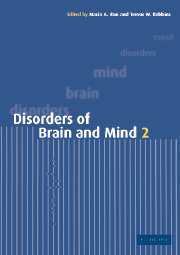Book contents
- Frontmatter
- Contents
- List of contributors
- Preface
- Part I Genes and behaviour
- 1 Genes and behaviour: cognitive abilities and disabilities in normal populations
- 2 Genes and behaviour: finding a genetic substrate for cognitive neuropsychiatry
- Part II Brain development
- Part III New ways of imaging the brain
- Part VI Imaging the normal and abnormal mind
- Part V Consciousness and will
- Part IV Recent advances in dementia
- Part VII Affective illness
- Part VIII Aggression
- Part IX Drug use and abuse
- Index
- Plate section
- References
2 - Genes and behaviour: finding a genetic substrate for cognitive neuropsychiatry
from Part I - Genes and behaviour
Published online by Cambridge University Press: 19 January 2010
- Frontmatter
- Contents
- List of contributors
- Preface
- Part I Genes and behaviour
- 1 Genes and behaviour: cognitive abilities and disabilities in normal populations
- 2 Genes and behaviour: finding a genetic substrate for cognitive neuropsychiatry
- Part II Brain development
- Part III New ways of imaging the brain
- Part VI Imaging the normal and abnormal mind
- Part V Consciousness and will
- Part IV Recent advances in dementia
- Part VII Affective illness
- Part VIII Aggression
- Part IX Drug use and abuse
- Index
- Plate section
- References
Summary
Introduction
Cognitive neuropsychiatry was recently defined (Halligan and David 2001) as a ‘systematic and theoretically driven approach to explain clinical psychopathologies in terms of deficits to normal cognitive mechanisms’. The aim of cognitive neuropsychiatry is to identify the neural substrates of cognitive mechanisms that, when impaired, may underlie the phenomenology of psychiatric disorder. Consequently, it is a quintessentially multidisciplinary endeavour, founded in both basic neuroscience and clinical psychiatry. The progress being made in identifying circumscribed brain circuits that are involved in specific cognitive tasks, with the aid of functional neuro-imaging techniques, is remarkable, yet relatively little discussion has been addressed to the issue of the genetic mechanisms that direct the development of these neurocognitive systems. There is increasing convergence between the identification of specific neural substrates and subjective experience, such as the recognition of certain emotions. The addition of genetics and developmental science to the research agenda will increase the power of the discipline to dissect aetiologies and pathological mechanisms.
Approaches to gene-finding in psychiatric research
Most psychiatric genetic research has focused on the hunt for genes that predispose to complex and heterogeneous clinical conditions, such as schizophrenia or manic depression (McGuffin et al. 2001). Additionally, human behavioural genetics has to date focused largely on the identification of genes that contribute to individual phenotypic variance in a trait (see Chapter 1 by Plomin).
Information
- Type
- Chapter
- Information
- Disorders of Brain and Mind , pp. 30 - 56Publisher: Cambridge University PressPrint publication year: 2003
